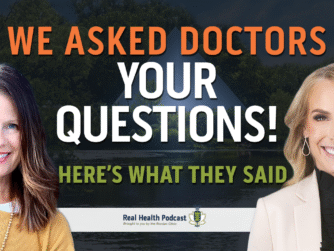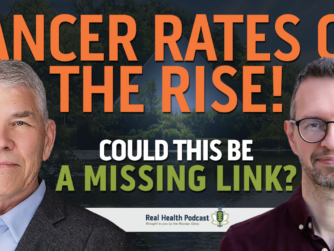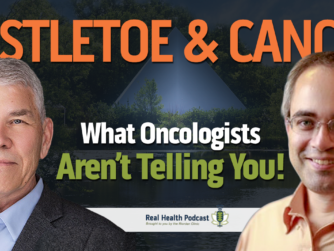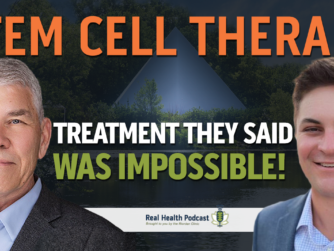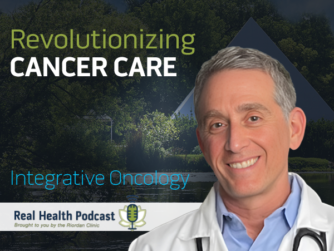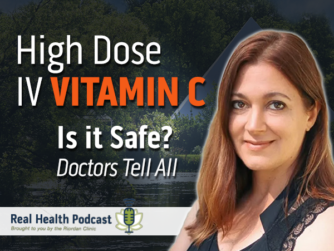Dr. Ron Hunninghake, MD, Chief Medical Officer, welcomes Dr. Virginia Osborne, ND. Dr. Osborne specializes in IV nutrient therapies. In this episode, she explains how IV nutrition can help enhance people’s health and helps heal from the inside out. She also discusses her new book “A Scientific Reference for Intravenous Nutrient Therapies: Direct Cellular Nutrition.”
Thank You To This Episode’s Sponsor
Episode Links and Promotions
A Scientific Reference for Intravenous Nutrient Therapy Direct Cellular Nutrition
IV Nutritional Therapy For Professionals
Episode Transcript
Disclaimer: The information contained on the Real Health Podcast and the resources mentioned are for educational purposes only. They are not intended as, and shall not be understood or construed as medical or health advice. The information contained on this podcast is not a substitute for medical or health advice from a professional who is aware of the facts and circumstances of your individual situation. Information provided by hosts and guests on the Real Health Podcast or the use of any products or services mentioned does not create a practitioner patient, relationship between you and any person’s affiliated with this podcast.
Intro: This is the Real Health Podcast brought to you by Riordan Clinic. Our mission is to bring you the latest information and top experts in functional and integrative medicine to help you make informed decisions on your path to real health.
Dr. Ron Hunninghake: Well, hello everyone. It’s Dr. Ron Hunninghake. We’re here again with the Real Health Podcast from Riordan Clinic. And it’s my distinct pleasure today to be interviewing, I guess we could say we’re kind of old friends. We’re certainly getting old. This is Dr. Virginia Osborne, who has been quite a force in the area of IV therapies, direct cellular nutrition, where you can get nutrition and a host of other benefits intravenously. And so Virginia, welcome to our podcast.
Dr. Virginia Osborne: Thank you. Thank you.
Dr. Ron Hunninghake: So you’ve just come out with a book, A Scientific Reference for Intravenous Nutrient Therapies: Direct Cellular Nutrition. So that must have been a labor of love.
Dr. Virginia Osborne: It was, it was. Our last book that we published was in 2004. And we have been working on this one ever since. With all the research, we’re happy to have it out there. Yes, finally.
Dr. Ron Hunninghake: Good. I want our listeners to be sure that they understand that there is quite a lot of good science underpinning the use of IV nutrients. And so I think you’re one of the foremost people to solidify that message, right?
Dr. Virginia Osborne: Correct. Correct. Yes.
Dr. Ron Hunninghake: Well, anyway, just for our listeners information, Dr. Osborne has been doing, oh my gosh, five to six seminars a year for the last 20 to 25 years as we were talking earlier. That is a lot of education for a lot of people. So you’ve really touched many, many doctors, naturopathic and integrative and functional doctors in their use of IV nutrition. And so tell us a little bit about how you got started in this and why you believe this is very important for people to know.
Dr. Virginia Osborne: Well, this is an interesting tale to tell. It did start before I went to medical school. And as I had been working as an RN at that time, I had individuals who were going out of the country to get IV nutrients. And they asked me, could you help me with this? And I had been studying nutrition all along anyway. So I was like, yes, of course. But then I went off to the naturopathic medical school in Portland, Oregon. And through that, had classmates who had also been working in labs and were interested. And so we collaborated and created amongst our classmates at the time a, so say the first clinic of IV nutrient therapies. And this is because our education is really steeped in nutrition and the research that’s been done on it. So throughout our education, we had that.
Dr. Virginia Osborne: So anyway, we developed that and we said, someday we’re going to take this on the road. And I had one colleague, Dan Carter and myself. So yeah, we did. And I guess, to say the rest is history, but it really launched us into keeping up with all of the research and including Dr. Paul Anderson into our group of lecturers and also a collaborator with that book that we just came out with. And that is something that it kept us up to date. It kept us aware of it, who was doing what around the world, as far as research into all of these and how did all of this nutrient research really play forward and be consistent throughout. And what we’ve learned through the years and things that changed as, we got our clinical experience as well, because everybody’s an individual, all of our chemistry doesn’t always work exactly the same.
Dr. Ron Hunninghake: Right. And I’m struck by the subtitle, Direct Cellular Nutrition. I think a lot of people assume if they put it in their mouth and it goes down their digestive tract, it’s going to make it to their cells in some kind of really good way, but maybe not. And can you tell us a little bit, how does IV nutrition enhance the effectiveness of certain nutrients and other substances that can enhance people’s health?
Dr. Virginia Osborne: Well, as we know, the digestive track is our gateway, and if it’s not working correctly, because you have all of that direct piece going on there, but if you’re not able to take up those nutrients, because you don’t have the right components or right genetics, IVs actually get the direct access to all of those cells. So it’s healing from the inside out. And that is what we have found.
Dr. Ron Hunninghake: Boy, that’s a great phrase. And I know a lot of our patients, especially when they’ve been ill for a long time, or if they have a serious illness like cancer, their digestive tracts are just not working as well. And we know a lot of people have leaky gut and they have other digestive problems. So this is a really important way to get nutrition to people who would otherwise not get it and not get well.
Dr. Virginia Osborne: Exactly, exactly. We have found.
Dr. Ron Hunninghake: Yeah. So we were talking earlier that this spans quite a large range of applications. Here at the Riordan Clinic, we’ve done, Dr. Riordan was instrumental in getting IV vitamin C research off the ground. Maybe we could start there because I know our listeners are all about IV vitamin C. What are just to kind of recapitulate, what are some of the advantages of doing vitamin C intravenously?
Dr. Virginia Osborne: Well, the advantages of vitamin C is one, it’s a water soluble vitamin. So it’s not something we humans can generate or create in our systems. So we need to absorb that from an extraneous source, so IV, oral, topical, whatever it might be, but IV is, you can also be able to infuse higher amounts into the system, whereas orally you cannot, without having side effects, more side effects. So the idea with the vitamin C is that with that, it also generates oxygenation within the system. It helps stimulate the immune system. We have multiple, multiple ways of how it is supporting the whole human cell itself. And it goes into the cell, into that, what we call the brains of the cell, the mitochondria, it helps generate oxygenation there. It helps with the transport of mechanisms throughout the cell itself. And that helps prevent abnormal cell development from occurring, as well as halting abnormal cell developments, such as we have in chronic diseases and cancer. And those types of autoimmune issues. These are just some of the, just tapping the few things that vitamin C does. It’s just an amazing nutrient for our systems.
Dr. Ron Hunninghake: Yeah. And at the lower doses, we’ll start our cancer patients on 15,000, which still is a big dose. But even at that point, it’s still working mostly as an antioxidant. But then as the dose goes up somewhere around 25, unless that’s changed, 25 grams or higher,
Dr. Virginia Osborne: That’s correct.
Dr. Ron Hunninghake: It becomes more of a pro-oxidant. And so,
Dr. Virginia Osborne: Correct.
Dr. Ron Hunninghake: That way you can attack infections, you can attack the cancer cells. It seems to penetrate and do a better job at the higher doses. But not everyone needs the higher doses, but it’s interesting how different doses cause different effects of the nutrient.
Dr. Virginia Osborne: Well, that’s what we’ve found. And even some people who benefit from lower doses adds an oxidant for themselves. And this is the interesting thing. I always start very low, like you do so that we build them up to the level that is appropriate for each individual.
Dr. Ron Hunninghake: Very good. What other kind of nutrients are you teaching about in terms of cancer care? Not that we want to just dwell only on cancer, but while we’re on that topic, what else can people get IV that is beneficial in a cancer situation?
Dr. Virginia Osborne: Well, I appreciate that. Cancer is certainly one that can be acute or chronic in many patients’ lives, as our viral components to all of that. And so what we, well, it’s all about the nutrients and it’s building up so that one, first of all, the patient is well hydrated because if you’re not well hydrated, you won’t absorb your nutrients as well. And that’s a key thing for everybody.
Dr. Virginia Osborne: And so whether we have the lower dose antioxidants where we add in all the B vitamins to get the cells, billions of cells in our bodies to up and functioning well, so that when we go higher with the vitamin C and the magnesium, the potassium, the calcium to help with that oxidative ability. So when we have individuals who have really been [inaudible 00:10:18] or malnutrition, or for all the reasons that happen, we have the ability to help build that up first and then go to the other treatments that we have that are available for individuals. And certainly anti-inflammatory is key piece to that. We add DMSO to a lot of ours for that anti-inflammatory effect, which is also very helpful for cancer patients who, it also has a anti-cancer effect as well.
Dr. Ron Hunninghake: Yeah. So yeah, we’ve in recent years, we’ve been having people stay for longer periods of time and we’re certainly trying to put more nutrition IVs, with all the things that you just mentioned in between IV vitamin C, because vitamin C just by itself, it can actually deplete potassium and some of the other minerals.
Dr. Virginia Osborne: Well, and the important part about that is too, is that the body and the cells require potassium for often transporting the nutrients across the cell membrane. So that’s the reason for why we add the potassium to it. The magnesium actually works in concert with the vitamin C or that antioxidant to oxidative abilities. So that is the other reason why we add in that magnesium as well as the benefits of magnesium are as huge as vitamin C and then the calcium, because vitamin C can be a mild chelator. And the calcium is sort of one of the top of the list of the minerals that it might take out. So we add some of that calcium in just to keep that balance going when we’re infusing those high dose vitamin Cs, but typically with the antioxidant we have quite a few nutrients we can add in and taurine is one of our bigger ones, because it is one of the best options for keeping the cell membrane healthy and allowing for nutrients to get in it and waste to get out.
Dr. Ron Hunninghake: Yeah. And Poly-MVA is a type of alpha-lipoic acid. And that is being used more often now. What are some of the functions of that in terms of cancer patients?
Dr. Virginia Osborne: Well, the benefits there, again, you’ve got some nutrients that are combined with that particular lipoic acid and it is done in a special setting. We can’t make that combo in our clinics, in our labs, but there’s a special, process that they do in order to bring that all together. So that for somebody who has limited or you’re looking at all kinds of reasons, whether it’s time or finances or whatever, but this is something that can help start boosting that. Your alpha-lipoic acid is also your, it’s a master antioxidant. So if we’re trying to achieve that goal, we can do it with smaller amounts of Poly-MVA.
Dr. Ron Hunninghake: And Dr. Burt Berkson, he made that association between alpha-lipoic acid IV and pancreatic cancer, and some other types of liver problems, that it was especially beneficial in those areas.
Dr. Virginia Osborne: Yeah. Alpha-lipoic acid in and of itself has been amazing. And yes, thanks to him for all the research. Yes.
Advertisement: There’s a lot more to this conversation and it’s coming up right after a quick break. Today’s podcast is brought to you by Bio-Center Laboratories. The Bio-Center laboratory provides state-of-the-art lab testing and diagnostic services for healthcare providers, laboratories, hospitals, and the general public. Lab tests available through Bio-Center include a comprehensive list of vitamins, minerals, fatty acids, amino acids, hormones, and pyrroles. We also provide a variety of standardized tests for disease markers. These markers include cardiovascular disease, diabetes, thyroid dysfunction, hormone imbalance, and more. Visit biocenterlab.org to learn more.
Dr. Ron Hunninghake: Now our naturopaths here at Riordan Clinic have been introducing mistletoe helleborus. I know mistletoe can be given IV. Now that goes way back to the German medicine. The Germans have been using that for a long time, haven’t they?
Dr. Virginia Osborne: Yes, they have. Yes, they have. And I’ve been using it actually for quite a few years throughout my whole career. And so we started with injectables at that point and that’s something also that patients can participate with is the sub-Q injections and then you can regulate there. And of course there is the intravenous and I’d say, be well understanding of mistletoe. There are different variations of mistletoe,
Dr. Ron Hunninghake: Right.
Dr. Virginia Osborne: And different products. And so you just have to know what’s the right one for the patient.
Dr. Ron Hunninghake: Very good. Let’s shift gears. And we hope we’re coming out of the pandemic. Now we have the post pandemic, the long haulers. Where does IV nutrition come in, in terms of people with chronic infections, chronic fatigue, long haul COVID, those kinds of infectious diseases? What are some of the things that we need to know about that?
Dr. Virginia Osborne: Well, that’s a bit interesting. Of course, a high topic for all of us. And we talk about this quite a lot, but so we have a number of protocols that we have designed and developed. And certainly in these last few years our, what we call our immune support and that one is, vitamin C is a big one for that, your B vitamins and of course, taurine, magnesium, and zinc. Zinc is huge. As we know, orally, there’s all those, the five that we utilize for that, the vitamin D, the vitamin C, multiple vitamins, fish oils, and zinc and vitamin D. I mean, these are, I think I said that twice, but the point is that what we need is also prevention as well as support for those who’ve already gone through it, or have these lingering comorbidities going on.
Dr. Virginia Osborne: So is it the adrenals? Do we need to support that? So we have certainly some pharmaceuticals that will help support doing that. But what we found was that a small amount of chelation, EDTA has been beneficial for this, as well as the nutrients that have been involved, because we’ve got a lot of toxins that are our new system. And let’s face it, we live on this ball called earth, it’s a toxic soup, from all the chemicals and things that are in the air and water. And so we also have to look at that detoxing effect, what are the underlying viruses? What about EBV? That’s a common one that has been often ignored and it tends to reactivate. So we have to be testing and checking for EBV.
Dr. Virginia Osborne: We know that if it’s thyroid, then we look for parvovirus B19. So these are the big ones that we find that have been lingering for years and years and years for people. And it just kind of reared its head with this particular current virus. So these are things that we have to look at is how can we support that immune system and how do we do that for each individual? So that if we’re looking at the lungs, we look at quercetin for that and NAC. NAC is a big one for crossing the blood brain barrier and detoxing the body and oxygenating. And so is the, of course it’s an also a good antioxidant. So those are the key ones that we look at. Yeah.
Dr. Ron Hunninghake: Well, with chelation, a lot of people associate EDTA chelation with just okay, heart disease, we’re going to chelate. And in recent years, one of our naturopaths has been doing a lot more chelation for the simple fact that if you’ve got lead, cadmium, aluminum and other heavy metals in your body, these poison your enzymes and your enzyme systems in your cells are the crucial part of cellular life. And if you’ve got a bunch of heavy metals clogging them up, you’re just not going to be functioning very well. You’re going to be tired, you’re going to have all kinds of chronic symptoms. And so it kind of opened my eyes to the fact that chelation can have broader benefits than just cardiovascular disease.
Dr. Virginia Osborne: Well, that was because the research was originally done on the cardiovascular disease, because they found that when they were back I think, it was World War II and,
Dr. Ron Hunninghake: Right.
Dr. Virginia Osborne: Then Naval, and all that sort of thing. But here we are fast forward 60, 70 years later, 80 years later. And we’ve got the benefits that we were seeing, that how many of us were exposed during the 50s and 60s, and how much was that genetic change carried on from that period of time, that exposure. So, and people always say to me, well, where did I get that from? I say, well, let’s see, how old are you, better living through chemistry back in the 50s and 60s, there was a lot of lead in the gasoline and how that spill over.
Dr. Virginia Osborne: And also like I’m in mining area, an old mining area, not current, but it is one of those that it’s seeped into the soils and people now 100 years later, 150 years later are being exposed to it as their wells are being dug into these areas that had high lead and high uranium, uranium has been showing up. So, and then we have Fukushima that deposited lots of valium about. So we just have constant stuff that we’re exposed to. And so we just have to find which individual has been, as we know, mercury effects, the nervous system, lead has affected the bones. And so we constantly have issues that develop and we can help individuals release that out so that it’s not blocking the nutrients getting into the cells.
Dr. Ron Hunninghake: Yeah. Have you done much with NAD infusions? There seems to,
Dr. Virginia Osborne: Yeah. Yes, you do. And actually we have a seminar coming up next weekend on that very topic for two days in Park City, Utah. For those who are interested, there is the ability to sign up for that still. I mean, it’s a virtual hybrid. That’s the,
Dr. Ron Hunninghake: Yes.
Dr. Virginia Osborne: Where we are these days with it. And so we have livestream as well as in person. And we are covering that. We have Dr. Ken Starr, who is an emergency med doc, who has a clinic also in Southern California that was dedicated to this and addictions. And we have a lot of research on NAD that we will be presenting on that. And yeah. So I’ve used it a lot and it’s been amazing.
Dr. Ron Hunninghake: Do you use it mostly for addictions, or there’s.
Dr. Virginia Osborne: No, no, not at all for me. Actually, no small amounts. And the key thing here is to start with small amounts because the more comorbidity, particularly in Lyme, the more reactive they get, just even with a small dose of NAD. And you have to forewarn your patient to know that this is going to happen. You’re going to get this flushing effect. It is a B3 derivative.
Dr. Ron Hunninghake: Right.
Dr. Virginia Osborne: So it has that nice and flush piece that really gets them going. It only lasts for a few seconds, but it is a little bit daunting for patients for the first time they experience it. So the key thing about that is start low, work it up, but it is one of the things for cancer patients that we find that has been really beneficial as well. And oftentimes one of the key things, so is curcumin if we could get it, and these are one of those points that we have… So out there in the world, beyond the United States borders, we have all those agents available too, that are not available in the US. So that’s when I speak of those. But NAD itself has been amazing. And for those who are fatigued and run down, oh my gosh, throw that in with a few nutrients and they’re good to go.
Dr. Ron Hunninghake: Well, it’s a key part of the mitochondria, the electron transport chain, the ability of the cell to make energy. And if you don’t have energy, you’re going to have dysfunction. And so really NAD would be almost a foundational thing for a lot of people.
Dr. Virginia Osborne: It is. It is. Thank you. Yeah.
Dr. Ron Hunninghake: Yeah. And so what about ozone therapies? There’s a lot of different ozone therapies and I don’t know. Do you teach that as well?
Dr. Virginia Osborne: Well, I, myself don’t teach it. I’ve utilized it for the last 25 years in my clinic. And so, I leave that to those who have decided to specialize in teaching that. So they do great, a great work with that. And I could go on and on about the benefits of ozone. Yeah.
Dr. Ron Hunninghake: Well, and we’ve just scratched the surface, but I think a lot of listeners will think, oh my gosh, I didn’t know that there was so many powerful IV therapies available. And yet we’re finding out, given the severity of chronic illness, we have just all kinds of increasing chronic illness in our world. We need more powerful interventions. And I think this is where intravenous therapy really shines.
Dr. Virginia Osborne: Well, I agree. Thank you. And it’s all about teamwork.
Dr. Ron Hunninghake: Well, thank you so much for being on our show. And I want you to just one more time, A Scientific Reference for Intravenous Nutrient Therapies: Direct Cellular Nutrition. So that probably was quite a, if you’ve been doing this for 25 years, that’s a lot of knowledge to put into one book.
Dr. Virginia Osborne: Well, and it was a lot of the research that we had and that we were able to gain, but also our clinical experience over the last 20 years has really come to bear in that book as well. Yeah.
Dr. Ron Hunninghake: And that’s where the rubber meets the road. It’s how it’s utilized. You can talk about something and how great it is, but it’s the clinical application that really makes the difference. And so thank you so much Dr. Virginia Osborne for being on Real Health and for making such a big difference in the lives of so many practitioners and in the people they serve, as we struggle to maintain real health in a difficult world. So thanks for being on the show.
Dr. Virginia Osborne: Well, thank you. And one more point, I just wanted let them know where they could find the book.
Dr. Ron Hunninghake: Okay.
Dr. Virginia Osborne: And we have it on our website at ivnutritionaltherapy.com as well as Amazon.
Dr. Ron Hunninghake: Okay. Very good. Thank you, Virginia. You take care.
Dr. Virginia Osborne: Thank you. Thank you, Dr. Ron.
Outro: Thank you for listening to the Real Health Podcast. If you enjoy this episode, be sure to subscribe and leave us a review. You can also find all of the episodes and show notes over at realhealthpodcast.org. Also, be sure to visit Riordanclinic.org, where you will find hundreds of videos and articles to help you create your own version of real health.


